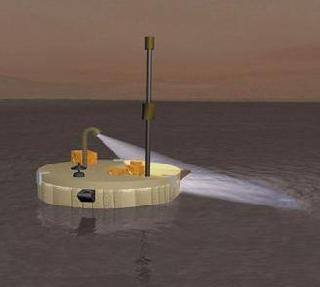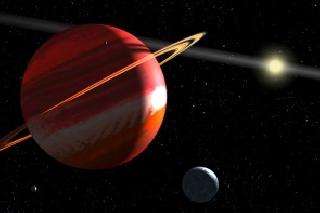
An artistic illustration of the Titan Mare Explorer (TiME) probe.
LONDON (PTI): British scientists, along with NASA, are planning to build the first “extraterrestrial boat” which they claim would be able to sail on the methane lake of Saturn’s largest moon Titan to explore chances of life there.
A team, led by Prof John Zarnecki of Open University, says that it wants to launch the robot craft towards Titan and parachute it on to Ligeia Mare, a sea of methane and ethane on its surface, The Observer reported.
Under the Titan Mare Explorer (TiME) probe, the robot boat would sail around this extraterrestrial sea for several months, exploring its coastline and measuring the winds and waves that sweep its surface.
“Waves on Titan’s seas will be far larger, but much slower, than on earthly oceans, according to our calculations.
That suggests Titan is the best spot in the solar system for surfing. The only trouble is that the temperature there is -180C. Either way you look at it, it is clear the place is pretty cool,” Prof Zarnecki said.
The mission to Titan – the only moon in the solar system with a thick atmosphere, of nitrogen and methane – would be the first exploration of a sea beyond Earth and could provide evidence about the possible existence of complex organic chemicals, the precursors of life, says the team.
“Methane is a gas on Earth, but because Titan is so cold it acts as a liquid there,” said Prof Zarnecki.
He added: “It exists as a liquid, a gas and a solid, just like water on Earth, depending on conditions in a particular area.
Methane also cycles between Titan's surface and its atmosphere, just as water does on Earth. It drives the weather there.”
Ultraviolet radiation from the Sun reacts with this methane, causing it to form complex hydrocarbons that slowly fall back to the surface. In short, it rains petrochemicals on Titan. Rivers of the stuff wash down valleys and form lakes.
According to their plan, the TiME probe would be fired at Titan on a billion-mile journey across the solar system.
Once it enters the moon's thick atmosphere the craft would parachute down towards the surface and then drop into the 300-mile-wide Ligeia Mare. It would then spend several months afloat on an oily sea taking measurement of waves, chemicals and other variables.
“The probe's main instrument will be a mass spectrometer, which will tell us exactly what the lake is made of. However, we also want to do things like depth-sounding,” said Ellen Stofan, project incharge of TiME.
The instruments would be powered by a small nuclear generator, because Titan is so distant from the Sun that solar panels cannot be used to provide power for detectors or transmitters.
In the case of TiME, launch would be in 2016, with the ship arriving seven years later, say the scientists.
“When the proposal for the TiME mission went in, it had a one-in-28 chance of success. Now NASA have shortlisted it, it has a one-in-three chance – that's getting serious. I didn't think I had a chance of returning to Titan in my career. Now that's all changed,” said Zarnecki.
 Previous Article
Previous Article Next Article
Next Article











The Indian Air Force, in its flight trials evaluation report submitted before the Defence Ministry l..
view articleAn insight into the Medium Multi-Role Combat Aircraft competition...
view articleSky enthusiasts can now spot the International Space Station (ISS) commanded by Indian-American astr..
view article